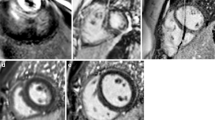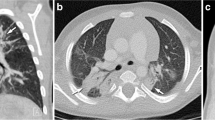Abstract
Abnormalities in gastrointestinal movement underlie various symptoms in the pediatric population. Although fluoroscopic, manometry, and ultrasonography remain important tools for studying gastrointestinal movement, none can depict the whole gastro-intestine full-size without radiation. The purpose of this study was to evaluate whether kinematic water selective excitation MR imaging (WATS-MR cine) could reveal gastrointestinal movement in childhood. Thirty-six patients (age: 3 to 17 years; 15 male and 22 female) underwent dynamically balanced first field echo (FFE) imaging with a thick slice of water selective excitation without breath hold. The WATS-MR cine was taken at three different times (preprandial, immediately postprandial, and 30-min postprandial) for sequential 5 min. Images were displayed in a cine mode at 10 times the normal speed, and the motion of water in each organ was evaluated. Movement of the stomach, small intestine, and colon could be observed together in a field. This study made it possible to evaluate both preprandial and postprandial gastrointestinal water movement. WATS-MR cine is useful for visualizing gastrointestinal water movement in accessible children older than 6 years without sedation. A cine mode at 10 times the normal speed provided characteristic images reflecting gastrointestinal water movement abnormalities in pediatric patients.




Similar content being viewed by others
References
Marciani L, Young P, Wright J et al (2001) Antral motility measurements by magnetic resonance imaging. Neurogastroenterol Mot 13:511–518
Watanabe Y, Ito T, Ando H et al (1996) Manometric evaluation of gastrointestinal motility in children with chronic intestinal pseudo-obstruction syndrome. J Pediatr Surg 31:233–238
Malagenade J-R (1998) Diagnostic methodology of small bowel motility problems. In: Champion MC, McCallum RW (eds) Physiology, diagnosis & therapy in GI motility disorders. The Medicine Publishing Foundation, Oxford, Toronto, Sydney, Philadelphia, pp 81–89
Beall DP, Fortman BJ, Lawler BC (2002) Imaging bowel obstruction: a comparison between fast magnetic resonance imaging and helical computed tomography. Clin Radiol 57:719–724
Katayama M, Masui T, Kobayashi S et al (2001) Evaluation of pelvic adhesions using multiphase and multislice MR imaging with kinematic display. AJR Am J Roentgenol 177:107–110
Takahara T, Fukusima T (2004) Intestinal obstruction. In: Takahara T, Ohgi K (eds) Clinical MRI at your fingertips. Medical View, Tokyo, pp 298–305
Milla PJ (1988) Introduction. In: Milla PJ (ed) Disorders of gastrointestinal motility in childhood. Wiley, Chichester, New York, Brisbane, Singapore, pp 1–14
Acknowledgements
The authors would like to thank Mr. Isanori Iwama, Aichi Children’s Health and Medical Center, for technical assistance during the procedures.
Author information
Authors and Affiliations
Corresponding author
Rights and permissions
About this article
Cite this article
Watanabe, Y., Ikegami, R. & Osuka, A. The usefulness of dynamically balanced FFE WATS-MR imaging with kinematic display for studying pediatric gastrointestinal disease. Ped Surgery Int 21, 868–872 (2005). https://doi.org/10.1007/s00383-005-1532-4
Published:
Issue Date:
DOI: https://doi.org/10.1007/s00383-005-1532-4




